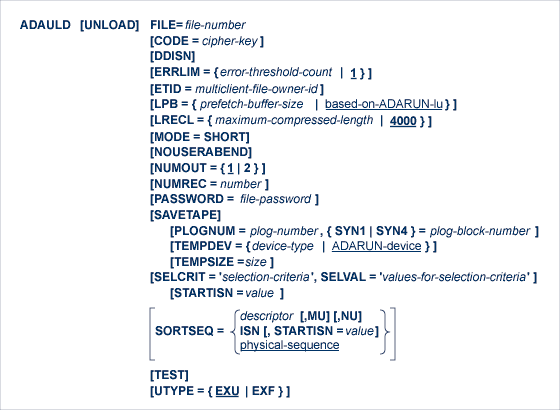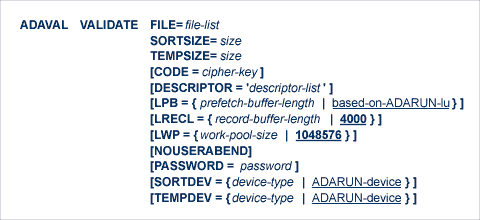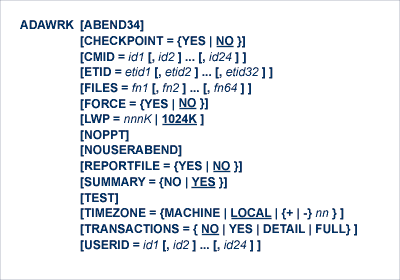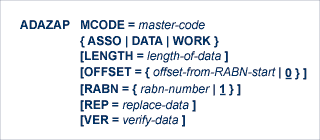| Utility Function | Use to... |
|---|---|
| ADAACK ACCHECK | Check the address converter for a specific file or range of files or for a specific ISN or range of ISNs. |
| ADACDC | Produce a file containing the delta of all changes made to the database over the period covered by the input protection logs. You can also use this utility to produce a file that lists each individual insert and delete transaction made to the database over the period covered by the input protection logs (without producing a delta of these changes). |
| ADACMP COMPRESS | Edit and compress data records that are to be loaded into the database. |
| ADACMP DECOMPRESS | Decompress individual files in the Adabas database. |
| ADACNV CONVERT | Convert a database to higher Adabas version. |
| ADACNV REVERT | Revert a database to a lower Adabas version. |
| ADADBS ADD | Add a new data set to the Associator or Data Storage. |
| ADADBS ALLOCATE | Allocate an extent of a specific size for an address converter, Data Storage, or normal or upper index. |
| ADADBS CHANGE | Change the standard length or format of a field. |
| ADADBS CVOLSER | Print the Adabas file extents on a given volume. |
| ADADBS DEALLOCATE | Deallocate a file extent for an address converter, Data Storage, or normal index or upper index. |
| ADADBS DECREASE | Decrease the size of the last data set currently being used for the Associator or Data Storage. |
| ADADBS DELCP | Delete checkpoint records. |
| ADADBS DELETE | Delete a file from a database. |
| ADADBS DSREUSE | Activate or deactivate the reuse of Data Storage blocks for a file. |
| ADADBS ENCODEF | Change the file encoding of a file. |
| ADADBS INCREASE | Increase the size of the last data set currently being used for the Associator or Data Storage. |
| ADADBS ISNREUSE | Reuse ISNs in a database. |
| ADADBS MODFCB | Modify various parameters for a non-system Adabas file. |
| ADADBS MUPEX | Set the maximum count for MU and PE fields in a database. |
| ADADBS NEWFIELD: | Add one or more fields to a file. |
| ADADBS ONLINVERT | Start an online invert process. |
| ADADBS ONLREORFASSO | Start an online process to reorder the Associator of specified files. |
| ADADBS ONLREORFDATA | Start an online process to reorder the Data Storage of specified files. |
| ADADBS ONLREORFILE | Start an online process to reorder the Associator and Data Storage of specified files. |
| ADADBS OPERCOM | Issue operator commands to the Adabas nucleus. |
| ADADBS PRIORITY | Set or change the Adabas priority of a user. |
| ADADBS RECORDSPANNING | Enable or disable record spanning for a file. |
| ADADBS RECOVER | Recover allocated space by rebuilding the free space table (FST). |
| ADADBS REFRESH | Set a file to empty status. |
| ADADBS REFRESHSTATS | Reset the statistical values maintained by the Adabas nucleus for its current session. |
| ADADBS RELEASE | Release a descriptor from the descriptor space. |
| ADADBS RENAME | Rename a file or database. |
| ADADBS RENUMBER | Change the number of a file in the database. |
| ADADBS REPLICATION | Activate or deactivate replication for an Adabas database file. |
| ADADBS REPTOR | Activate, deactivate, open, or close an Event Replicator for Adabas resource. |
| ADADBS RESETDIB | Reset entries in the active utility list. |
| ADADBS RESETPPT | Resets the PPT blocks on the Associator data set. |
| ADADBS SPANCOUNT | Count and display the number of records in a file that are spanned. |
| ADADBS TRANSACTIONS | Suspend and resume update transaction processing for the database. |
| ADADBS UNCOUPLE | Uncouple files in the database. |
| ADADCK DSCHECK | Check Data Storage and the Data Storage space table (DSST) of specified files in the database. |
| ADADEF DEFINE | Define a database and checkpoint file. |
| ADADEF MODIFY | Change field encodings. |
| ADADEF NEWWORK | Define a Work file. |
| ADAFRM | Format Adabas database components. |
| ADAICK ACCHECK | Check the address converter of a specified database file. |
| ADAICK ASSOPRINT | Print and dump Associator blocks. |
| ADAICK BATCH | Set the printout width to 132 characters per line. |
| ADAICK DATAPRINT | Print and dump Data Storage blocks for specified RABNs. |
| ADAICK DSCHECK | Print and dump the content of Data Storage records in a file. |
| ADAICK DUMP | Request that blocks be printed in dump format. |
| ADAICK FCBPRINT | Print and dump the file control block (FCB) of a file. |
| ADAICK FDTPRINT | Print and dump the field definition table of a file. |
| ADAICK GCBPRINT | Print and dump the general control blocks (GCBs). |
| ADAICK ICHECK | Check the index against the address converter. |
| ADAICK INT | Request that blocks be printed in interpreted print format. |
| ADAICK NIPRINT | Print and dump the normal index for a file. |
| ADAICK NOBATCH | Set the print width to 80 characters per line. |
| ADAICK NODUMP | Suppress dump print format. |
| ADAICK NOINT | Suppress interpreted print format. |
| ADAICK PPTPRINT | Print and dump the parallel participant table (PPT). |
| ADAICK UIPRINT | Print and dump the upper index for a file. |
| ADAINV COUPLE | Define one descriptor for each of two files to be coupled. |
| ADAINV INVERT | Create descriptors, subdescriptors, superdescriptors, hyperdescriptors, phonetic descriptors or collation descriptors for existing fields in a file. |
| ADALOD LOAD | Load a file into the database. |
| ADALOD UPDATE | Add or delete a large number of records (ISNs) to or from an existing file. |
| ADAMER | Run the ADAM estimation. This utility produces statistics that indicate the number of Data Storage accesses required to find and read a record when using an ADAM descriptor. |
| ADAORD REORASSO | Reorder the Associator. |
| ADAORD REORDATA | Reorder Data Storage. |
| ADAORD REORDB | Reorder the database. |
| ADAORD REORFASSO | Reorder the Associator for a single file. |
| ADAORD REORFDATA | Reorder Data Storage for a single file. |
| ADAORD REORFILE | Reorder a file. |
| ADAORD RESTRUCTUREDB | Restructure the database. |
| ADAORD RESTRUCTUREF | Restructure single files. |
| ADAORD STORE: Store Files | Load one or more files into an existing database using output produced by the ADAORD RESTRUCTURE functions. |
| ADAPLP | Print data protection records from the protection log (PLOG) or Work data sets. |
| ADAPRI | Print the contents of a block (or range of blocks) contained in the Associator, Data Storage, Work, temp, sort, multiple data set command log, multiple data set protection log, or the recovery log data set. |
| ADARAI CHKDB | Check that the recovery status of the nucleus is the status specified by the CHKDB function (active or inactive). |
| ADARAI DISABLE | Disable recovery logging by setting the RLOG table (control block) to inactive status. |
| ADARAI LIST | View the recovery log contents in table form. |
| ADARAI PREPARE | Initialize and start recovery logging to the recovery log. |
| ADARAI RECOVER | Build a recovery job stream for recovering the Adabas database or selected database files. |
| ADARAI REMOVE | Disable recovery logging by updating the Associator GCBs to indicate that recovery logging (that is, the Recovery Aid) is no longer active in the database, and that information will no longer be recorded in the recover log (RLOG). |
| ADAREP | Request a database status report. |
| ADARES BACKOUT SIBA | Back out updates applied between two specified checkpoints using the sequential protection log (SIBA). |
| ADARES BACKOUT DPLOG or MPLOG | Back out updates applied between two checkpoints contained on the same dual or multiple protection log. |
| ADARES CLCOPY | Copy the dual command log. |
| ADARES COPY | Copy a sequential protection log or save tape. |
| ADARES MERGE CLOG | Merge nucleus cluster command logs. |
| ADARES PLCOPY | Copy protection log data to a sequential data set. |
| ADARES REGENERATE | Reapply all the updates performed between two checkpoints. |
| ADARES REPAIR | Repair one or more Data Storage blocks, using the protection log and the output of the ADASAV utility. |
| ADASAV RESTONL | Restore a database from a database SAVE data set created while the Adabas nucleus was active. |
| ADASAV RESTONL FILES | Restore files to their original RABNs in an existing database. Files are restored from a file or database SAVE data set created while the Adabas nucleus was active. |
| ADASAV RESTONL FMOVE | Restore files to any free space in an existing database. Files are restored from a file or database SAVE data set created while the Adabas nucleus was active. |
| ADASAV RESTONL GCB | Restore the general control blocks (GCBs), Associator RABNs 3-30 of the database, the checkpoint file, the security file (if present), and all specified files. These file structures are restored from a database SAVE data set created while the Adabas nucleus was active. |
| ADASAV RESTORE | Restore a database from a database SAVE data set created while the Adabas nucleus was inactive. |
| ADASAV RESTORE FILES | Restore files to their original RABNs in an existing database. Files are restored from a file or database SAVE data set created while the Adabas nucleus was inactive. |
| ADASAV RESTORE FMOVE | Restore files to any free space in an existing database. Files are restored from a file or database SAVE data set created while the Adabas nucleus was inactive. |
| ADASAV RESTORE GCB | Restore the general control blocks (GCBs), Associator RABNs 3-30 of the database, the checkpoint file, the security file (if present), and all specified files. These file structures are restored from a database SAVE data set created while the Adabas nucleus was inactive. |
| ADASAV RESTPLOG | Restore changes contained in the protection log (PLOG) to the already restored database or files. |
| ADASAV SAVE | Save the contents of the database to a sequential data set. |
| ADASAV SAVE FILES | Save the contents of one or more files to a sequential data set. |
| ADASEL | Select and decompress information in the Adabas sequential (SIBA) or dual/multiple (PLOG) protection log and write it to a print data set (DDDRUCK/ DRUCK) or a user-specified output data set. |
| ADAULD UNLOAD FILE | Unload a specified Adabas file. |
| ADAVAL | Validate any or all files within an Adabas database except the checkpoint and security files. |
| ADAWRK | Produce reports from records in the autorestart area of Work part 1. This information can be used when the database autostart fails and the database will not come up. It can help you determine how to handle database recovery. |
| ADAZAP | Display (in hexadecimal format) and optionally change the contents of the Associator, Data Storage, or Work data sets. |
| Field Definition Statements | Define or modify a field definition. Field definition statements can be specified in various Adabas utility functions. |


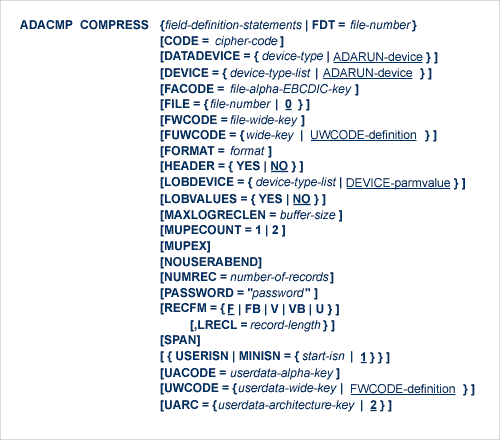
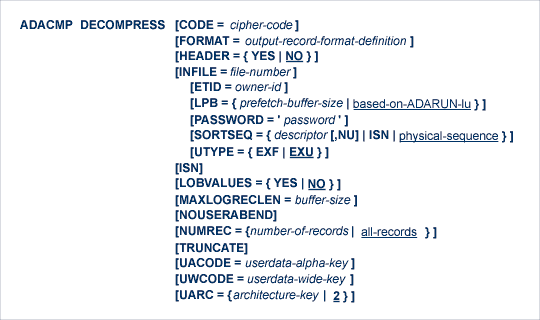
The following syntax must be followed when entering field definitions. A minimum of one and a maximum of 926 definitions may be specified.
| Statement Type | Syntax |
|---|---|
| Field and Group |
|
| Periodic Group |
|
| Collation descriptor |
|
| Hyperdescriptor |
|
| Phonetic descriptor |
|
| Subdescriptor |
|
| Subfield |
|
| Superdescriptor |
|
| Superfield |
|
User comments may be entered to the right of each definition. At least one blank must be present between a definition and any user comments.










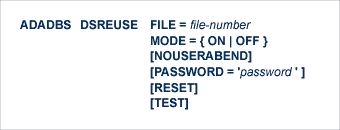


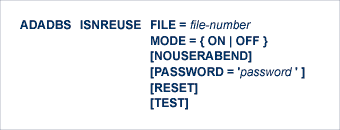
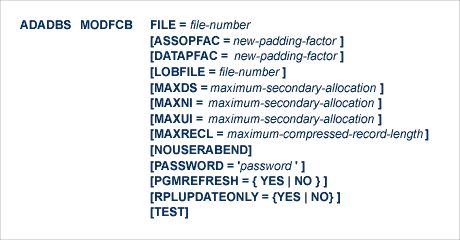
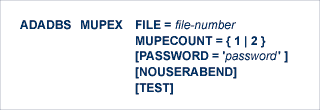

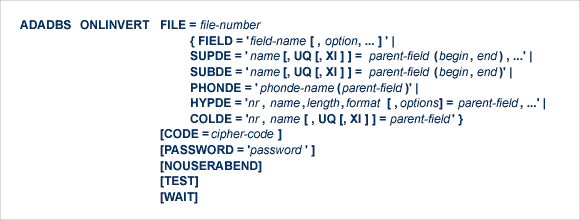



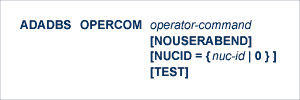
The following Adabas operator commands can be used in the ADADBS OPERCOM utility function:

This command terminates an Adabas session normally. No new users are accepted after this command has been issued. ET logic updating is continued until the end of the current logical transaction for each user. After all activity has been completed as described above, the Adabas session is terminated.
In nucleus cluster environments, the GLOBAL option can be used to terminate the Adabas session in all active cluster nuclei.

Lock a file in advance to ensure that an EXU, EXF, or UTI user will have exclusive control of the specified file. The advance-lock prevents new transactions from using the file. Once all current users have stopped using the file, the exclusive-control user has the lock. Until then, the exclusive-control user must wait.
To remove the advance lock without running the utility, see the RALOCKF command.
This command is not available
in single user mode; or
for a read-only nucleus.

Cancel the Adabas session immediately. All command processing is immediately suspended. A pending autorestart is in effect which in turn causes the autorestart routine to be executed during the initialization of the next Adabas session.
In nucleus cluster environments, the GLOBAL option can be used to cancel the Adabas session in all active cluster nuclei.

Switches automatic command log merging (ADARUN CLOGMRG parameter value) on or off in nucleus cluster environments.
The CLOGMRG command is global by definition and affects all nuclei in the cluster. If a NUCID is specified, it is ignored.

Note:
The CLUFREEUSER command is only valid in cluster environments. It can
be issued against the local nucleus only or, with the GLOBAL option, against
all active and inactive nuclei in the cluster.
Delete leftover user table elements (UTEs) in common storage that are no longer associated with user queue elements (UQEs) in a nucleus where:
| Parameter | Is... |
|---|---|
| TNA |
A decimal number specifying the timeout value in seconds. UTEs that are not used during the time specified may be deleted if other conditions are fulfilled. If TNA= is not specified, UTEs may be deleted without regard to their recent use. |
| UID |
A character string or hexadecimal byte string, as follows:
A character string must be enclosed in apostrophes if it contains characters other than letter, digits, or embedded '-' signs. If a specified character string is less than 8 characters long, it is implicitly padded with blanks. If a specified hexadecimal string is shorter than 16 hexadecimal digits, it is implicitly padded with binary zeros. If the UID string ends with a '*' (or X'5C'), the preceding characters are treated as a user ID prefix: only the prefix is needed for an argument match. If the last 8 bytes of a user's 28-byte communication ID match a specific user ID or user ID prefix, that user's UTE may be deleted if other conditions are fulfilled. If UID= not specified, UTEs may be deleted regardless of their user IDs. |
| FORCE |
Indicates that leftover UTEs are to be deleted even if the users are due a response code 9, subcode 20. If FORCE is not specified, such UTEs are not deleted. Before using the FORCE parameter, ensure that the users owning the UTEs to be deleted will not expect any of their transactions to remain open. |
| GLOBAL |
Indicates that leftover UTEs throughout the Adabas cluster are to be deleted if they are no longer associated with UQEs and are eligible according to the other specified parameters. Additionally and subject to the other rules, leftover UTEs are deleted if their assigned nuclei have terminated since their last use. If GLOBAL is not specified, only UTEs assigned to the local nucleus and used since the nucleus start are eligible for deletion. |
| NUCID |
Identifies the ID of the specific nucleus that should be used to process the command. |

Dynamically override the ADARUN CT parameter value; that is, the maximum number of seconds that can elapse from the time an Adabas command has been completed until the results are returned to the user through interregion communication (which depends on the particular operating system being used). The minimum setting is 1; the maximum is 16777215.
In nucleus cluster environments, the CT command is global by definition and affects all nuclei in the cluster. If a NUCID is specified, it is ignored.

Display the user queue element (UQE) of each user who has executed at least one Adabas command within the last 15 minutes.
In nucleus cluster environments, the NUCID=0 option can be used to display information for all active cluster nuclei. Information is displayed for each nucleus, one after the other.

Display all posted command queue elements (CQEs). Each CQE's user ID, job name, and buffer length is displayed.
In nucleus cluster environments, the NUCID=0 option can be used to display information for all active cluster nuclei. Information is displayed for each nucleus, one after the other.

Display data integrity block (DIB). This block contains entries indicating which Adabas utilities are active and the resources being used by each utility. The DDIB function can be performed with either an active or an inactive nucleus.
In nucleus cluster environments, the information displayed by the DDIB command is global; the command can be run on any nucleus.

Display Adabas Delta Save Facility (DSF) status. The Adabas nucleus displays the DSF status on the operator console as well as in the ADADBS job protocol.
This function is only available if the nucleus is run with the parameter ADARUN DSF=YES.
In nucleus cluster environments, the information displayed by the DDSF command is global; the command can be run on any nucleus.

Displays the number of access, update, EXU, and UTI users for the specified files. User types are totaled for each file, and are listed by file. Up to five files can be specified in this command. Up to 798 users are displayed.
In nucleus cluster environments, the NUCID=0 option can be used to display information for all active cluster nuclei. Information is displayed for each nucleus, one after the other.

Displays the count of commands processed for the specified file so far during the current session.
In nucleus cluster environments, the NUCID=0 option can be used to display information for all active cluster nuclei. Information is displayed for each nucleus, one after the other.


In nucleus cluster environments, the NUCID=0 option can be used to display information for all active cluster nuclei. Information is displayed for each nucleus, one after the other.

Display the number of posted command queue elements (CQEs) waiting to be selected.
In nucleus cluster environments, the NUCID=0 option can be used to display information for all active cluster nuclei. Information is displayed for each nucleus, one after the other.

Display the number of ISNs currently in the hold queue.
In nucleus cluster environments, the NUCID=0 option can be used to display information for all active cluster nuclei. Information is displayed for each nucleus, one after the other.

Display the number of current users.
In nucleus cluster environments, the NUCID=0 option can be used to display information for all active cluster nuclei. Information is displayed for each nucleus, one after the other.

Note:
Not currently available for use with Adabas Parallel Services cluster nuclei.
Display status of each active reorder or invert online process together with the process ID.
In nucleus cluster environments, the NUCID=0 option can be used to display information for all active cluster nuclei. Information is displayed for each nucleus, one after the other.


Display the allocated pool space and the highest use level ('high water mark') reached so far during the current session by record count and by percent for the following resources:
pool for global transaction IDs (XIDs; nonzero only with Adabas Transaction Manager)
cluster block update redo pool (nonzero only for a cluster nucleus with ADARUN LRDP greater than zero)
The actual values are displayed in nucleus message ADAN28 described in the Adabas Messages and Codes documentation.




Display all user queue elements (UQEs).
In nucleus cluster environments, the NUCID=0 option can be used to display information for all active cluster nuclei. Information is displayed for each nucleus, one after the other.

Display a user queue element for the specified Adabas-assigned user ID as follows:
DUQE=X'A3CF2'
The user ID must be entered in hexadecimal format. Do not use a job name for the user ID.
In nucleus cluster environments, NUCID must always be specified because the user ID is not unique to the cluster.

Display utility user queue elements (UQEs).
In nucleus cluster environments, the NUCID=0 option can be used to display information for all active cluster nuclei. Information is displayed for each nucleus, one after the other.

Close the current dual or multiple Command log and switch to the other dual or another multiple Command log. This command is valid only if dual or multiple command logging is in effect.
In nucleus cluster environments, the GLOBAL option can be used to switch the dual or multiple command log in all cluster nuclei at the same time.

Close the current dual or multiple data Protection log and switch to the other dual or another multiple Protection log. This command is valid only if dual or multiple data protection logging is in effect.
In nucleus cluster environments, the GLOBAL option can be used to switch the dual or multiple protection log in all cluster nuclei at the same time.

Stop Adabas session. A BT (backout transaction) command is issued for each active ET logic user. The Adabas session is then terminated; no dumps are produced.
In nucleus cluster environments, the GLOBAL option can be used to halt the Adabas session in all active cluster nuclei.

Lock the specified file. The specified file will be locked at all security levels.

Lock the specified file for all non-utility use. Adabas utilities can use the file normally.

Lock the specified file for all users except EXU or EXF users. EXU and EXF users can use the file normally. The lock is released automatically when an EXU user issues an OP command.


Begin logging as indicated by xx for each command logged where xx is one of the following:


Stop or prevent logging of xx where xx is one of the following:

Note:
Not currently available for use with Adabas Parallel Services cluster nuclei.
Resume a previously suspended online reorder or invert process.
In a cluster environment, NUCID must always be specified because the online process ID is not unique to the cluster.

Note:
Not currently available for use with Adabas Parallel Services cluster nuclei.
Stop an online reorder or invert process cleanly. The process continues up to its next interrupt point in order to produce a consistent state, and then terminates after performing all necessary cleanup.
In a cluster environment, NUCID must always be specified because the online process ID is not unique to the cluster.

Note:
Not currently available for use with Adabas Parallel Services cluster nuclei.
Suspend an online reorder or invert process. The process continues up to its next interrupt point in order to produce a consistent state, performs a command throwback, and enters a state where it cannot be selected for processing. This command is useful if the online process is consuming too much of the nucleus resources.
In a cluster environment, NUCID must always be specified because the online process ID is not unique to the cluster.

Note:
Not currently available for use with Adabas Parallel Services cluster nuclei.
Remove the advance lock on the specified file (see ALOCKF command) without running the utility.

Note:
Not currently available for use with Adabas Parallel Services cluster nuclei.
Remove the advance lock on all files for which it has been set (see ALOCKF command) without running the utility.

Terminate online dump status. This command is normally used if online execution of the ADASAV utility has terminated abnormally.

Note:
Not currently available for use with Adabas Parallel Services cluster nuclei.
Switches READONLY status on or off.
In nucleus cluster environments, the READONLY command is global by definition and affects all nuclei in the cluster. If a NUCID is specified, it is ignored.

Note:
Not currently available for use with Adabas Parallel Services cluster nuclei.
Deactivate Adabas Review; change from hub mode to local mode; specify or change the Adabas Review hub with which a nucleus communicates.

Stop all users who are using the specified file. Any open transactions of the stopped users are backed out. Unless PURGE is also specified, a stopped user who returns (by sending a command) receives response code 9.
If the optional PURGE parameter is specified, the stopped users are also deleted (their user queue elements are removed from the user queue).
This command does not stop EXF or UTI users.
The following is an example of using the PURGE parameter:
ADADBS OPERCOM STOPF=5,PURGE
Caution:
If Adabas is running with ADARUN OPENRQ=NO (specifying that users
are not required to issue an OP as the first command of the session), run the
STOPF command with PURGE only if you are certain that
the users to be deleted are no longer active. If a user with an open
transaction is deleted, but then returns (by sending a command), no indication
is given about the transaction backout. If the user continues the transaction,
logical inconsistencies in the database could occur.

Stop all users who have not executed a command during the specified time interval (in seconds). Any open transactions of the stopped users are backed out. Unless PURGE is also specified, a stopped user who returns (by sending a command) receives response code 9.
This command does not stop EXF or UTI users.
If the optional PURGE parameter is specified, the stopped users are also deleted (their user queue elements are removed from the user queue).
The following is an example of using the PURGE parameter:
ADADBS OPERCOM STOPI=3600,PURGE
Caution:
If Adabas is running with ADARUN OPENRQ=NO (specifying that users
are not required to issue an OP as the first command of the session), run the
STOPI command with PURGE only if you are certain that
the users to be deleted are no longer active. If a user with an open
transaction is deleted, but then returns (by sending a command), no indication
is given about the transaction backout. If the user continues the transaction,
logical inconsistencies in the database could occur.

Stop and delete the user with the Adabas-assigned user ID (in the form shown in the display commands), or stop and delete all users with the specified job name (job-name). Any open transaction by the stopped users will be backed out.
Caution:
If Adabas is running with ADARUN OPENRQ=NO (specifying that users
are not required to issue an OP as the first command of the session), run the
STOPU command only if you are certain that the users to be deleted are no
longer active. If a user with an open transaction is deleted, but then returns
(by sending a command), no indication is given about the transaction backout.
If the user continues the transaction, logical inconsistencies in the database
could occur.
Note:
The STOPU=X'userid'
command is not allowed for online reorder or invert processes. See the
ONLSTOP=X'identifier'
command instead.
The user ID must be specified in hexadecimal format; for example:
STOPU=X'1CF2'
In a cluster environment, NUCID must always be specified because the user ID is not unique to the cluster.

Force resynchronization of all ET users on the nucleus. The nucleus waits for all ET users to reach ET status before continuing.

Set non-activity time limit (in seconds) for users where u is one of the following:
If specified, time must be a value greater than zero; it overrides the ADARUN value.
In nucleus cluster environments, the TNAu commands are global by definition and affect all nuclei in the cluster. If a NUCID is specified, it is ignored.

Set transaction time limit (in seconds) for ET logic users. If specified, this value must be greater than zero; it overrides the ADARUN value. In nucleus cluster environments, the TT command is global by definition and affects all nuclei in the cluster. If a NUCID is specified, it is ignored.

Unlock the specified file and restore its usage to the prelocked status.

Unlock the specified file for utility use and restore it to its prelocked status for non-utility users.

Unlock the specified file and restore its usage to the prelocked status.

Note:
Not currently available for use with Adabas Parallel Services cluster nuclei.
Switch UTIONLY status on or off.
In nucleus cluster environments, the UTIONLY command is global by definition and affects all nuclei in the cluster. If a NUCID is specified, it is ignored.
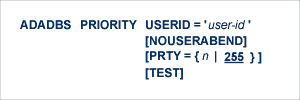



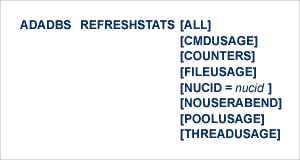
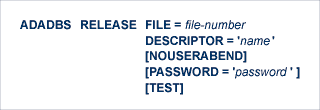
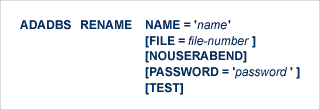









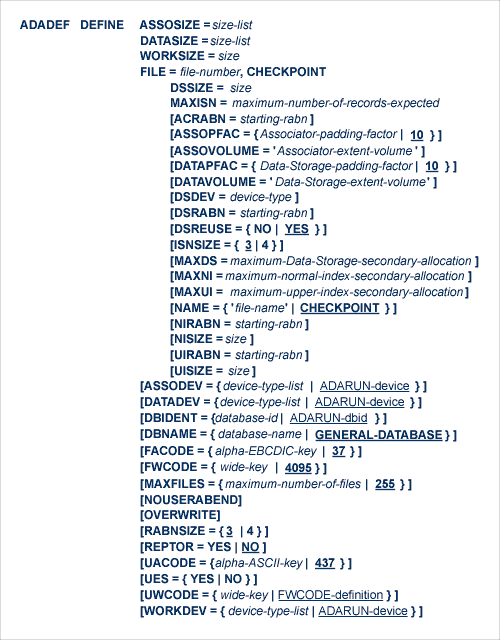


To format the Associator (ASSO) or Data Storage (DATA) data sets, use this syntax:

To format the Work (WORK), command log (CLOG), protection log (PLOG), or sort (SORT) data sets, use this syntax:

To format the recovery log (RLOG), use this syntax:

To format the Temp (TEMP) data set, use this syntax:

To reformat blocks of an existing Associator, Data Storage, or Work data set, use this syntax:





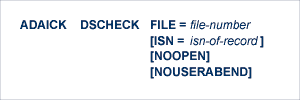












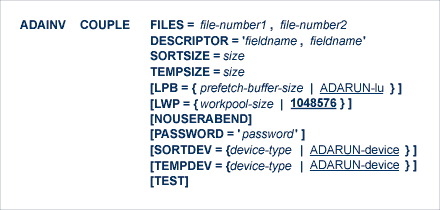
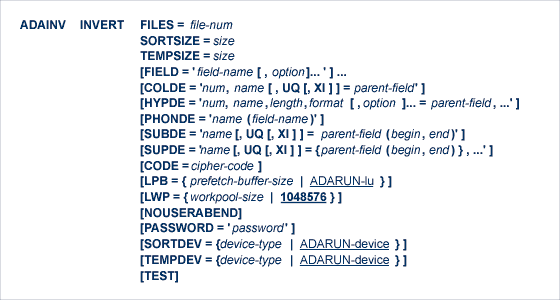
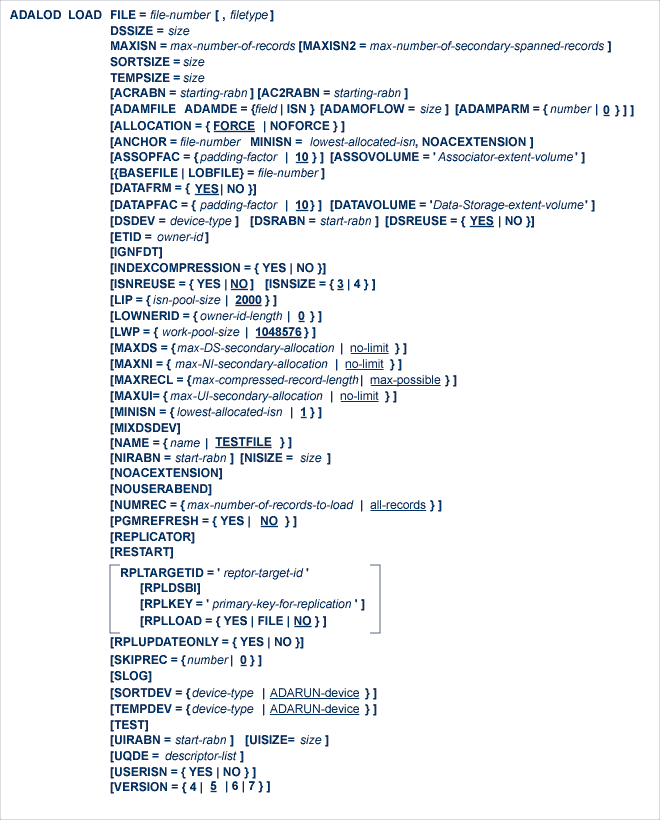
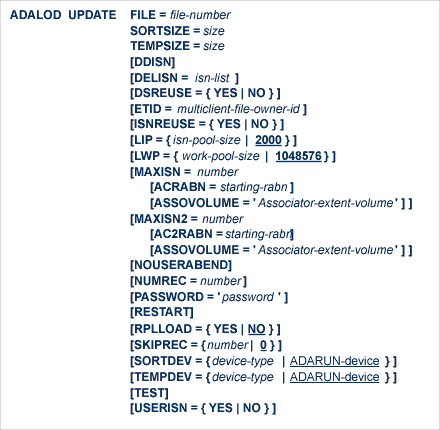


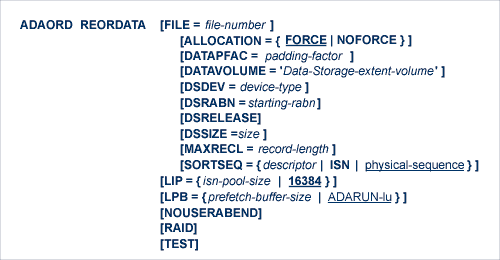
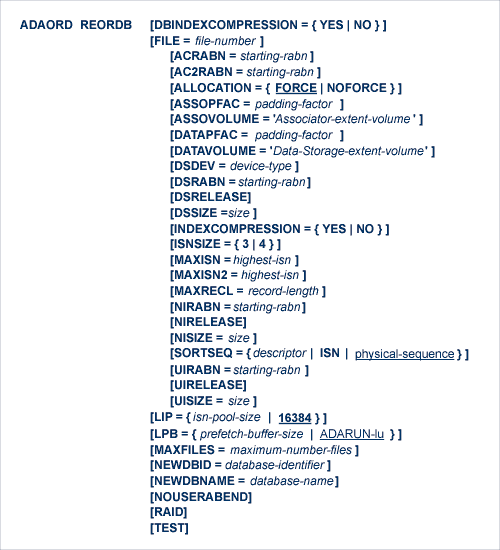
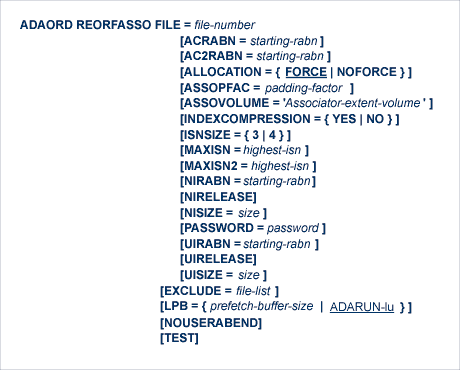

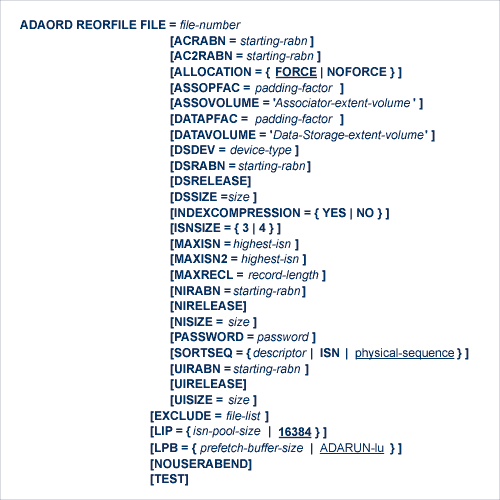
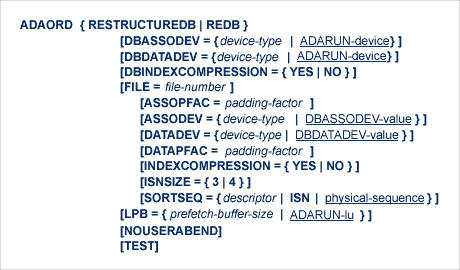
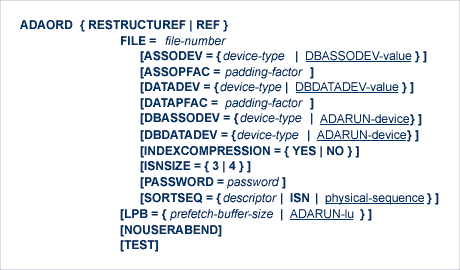
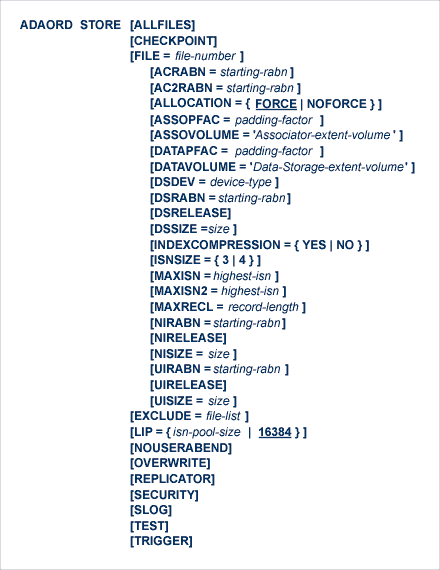
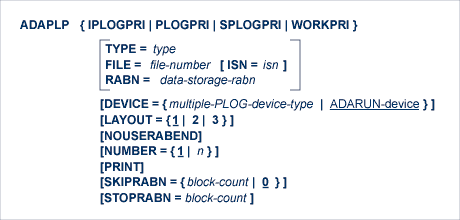
where type is one of the following:
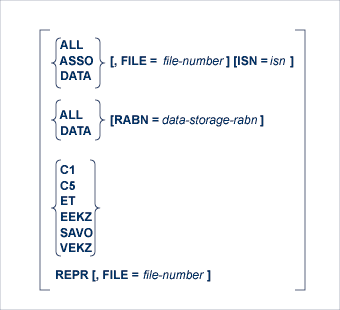
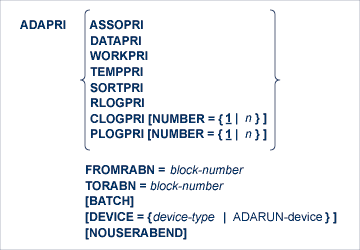




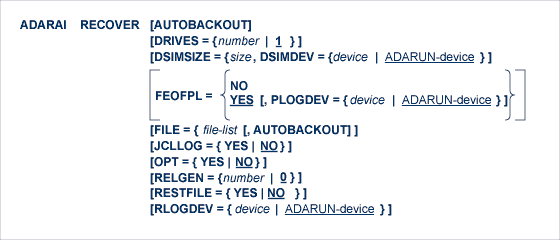

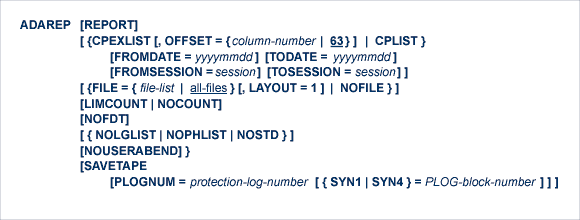
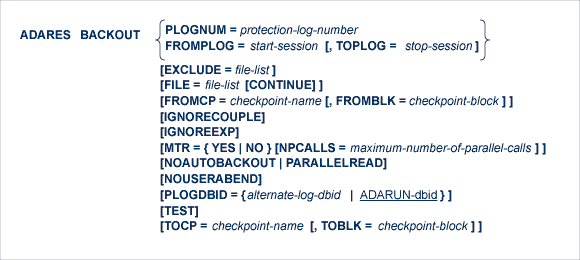
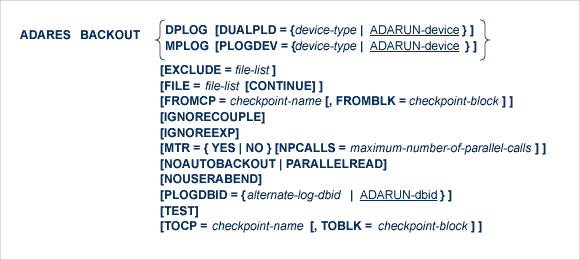

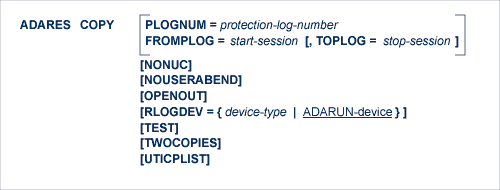

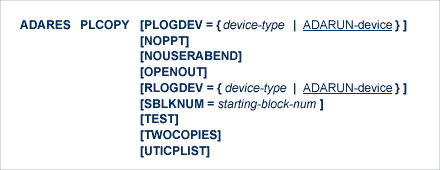
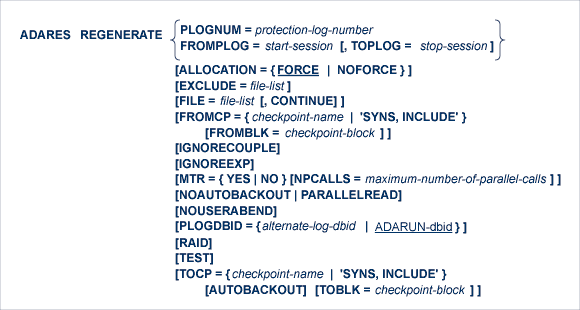

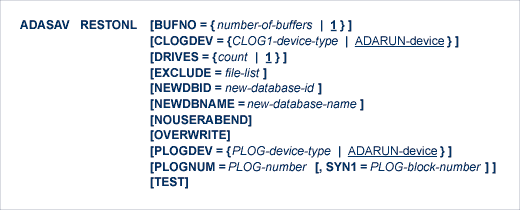
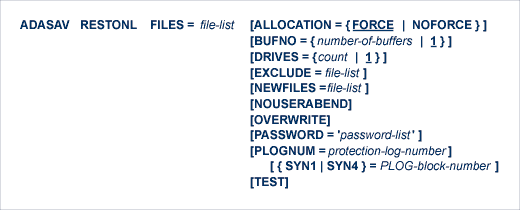
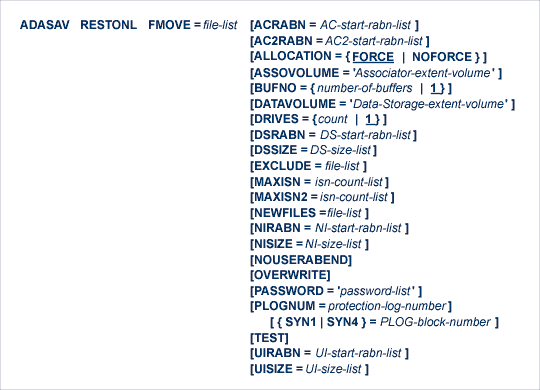

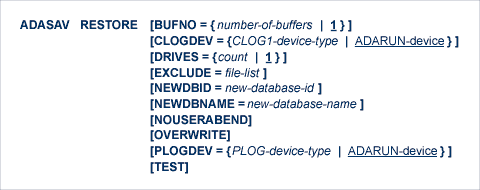
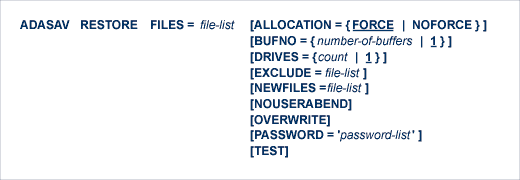
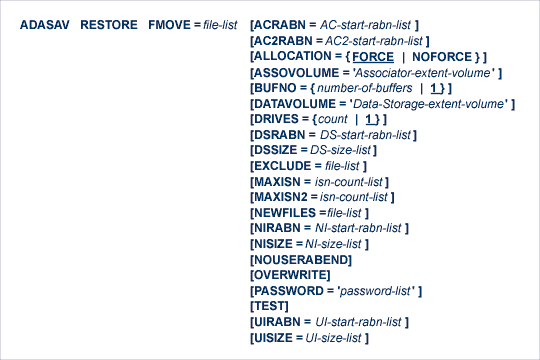
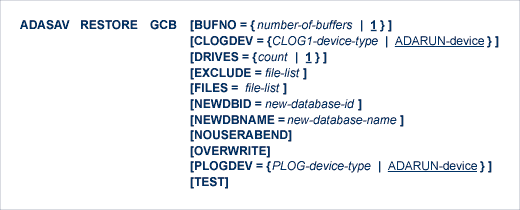

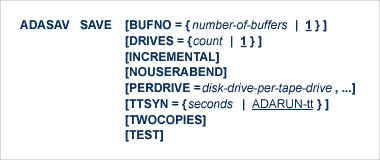
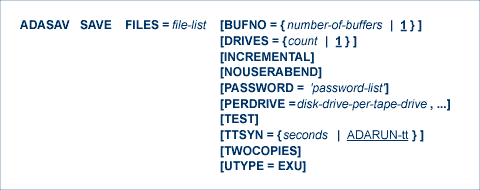
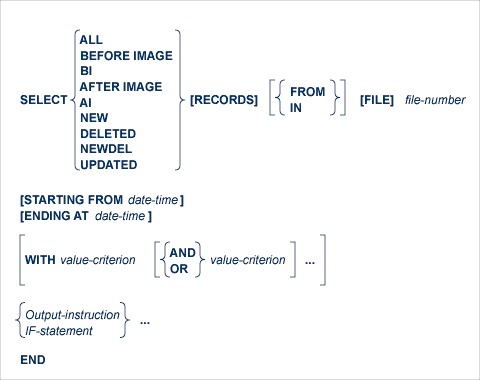
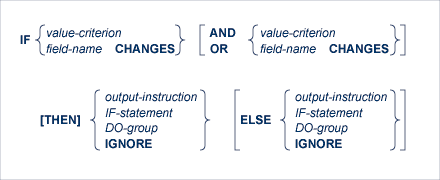

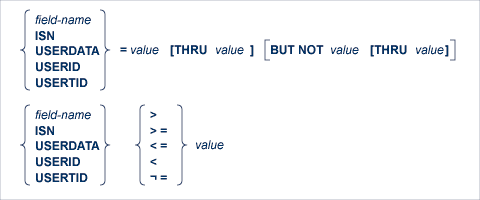

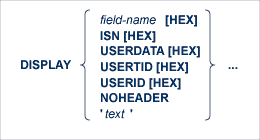
ADASEL global parameters override default table and buffer sizes. Overrides are in effect only for the ADASEL run in which the SET GLOBALS statement is specified.
If used, SET GLOBALS must be the first ADASEL input statement. Comment statements can precede it. The statement has the following syntax:

No spaces are permitted between the parameter name, the equal sign, and the value. However, at least one space must separate parameters. Special characters are not permitted as separators. If multiple lines are used, the SET GLOBALS keyword must be repeated on each line. The first non-blank character string that does not begin with a parameter name terminates the SET GLOBALS statement. Thus, trailing comments are not permitted.
ADASEL provides the following global parameters. Default values are underscored.
| Parameter | Description |
|---|---|
LST={len | 12000 } |
Length of the statement table, which is used to store the
translated ADASEL statements. Depending on its complexity, a statement is
translated into one or more segments. Each segment is 44 bytes plus a value
length. For example: IF BA EQ 'SMITH'... requires 49 bytes: 44
bytes plus 5 bytes for "SMITH". The default table
size (12 ,000 bytes) handles approximately 200 segments. If the table size is
exceeded, a SEL003 error occurs.
|
NCFLD={n | 10} NCUPD={n | 10} |
The maximum count of
"field-name CHANGES"
statements allowed in the selection query, and the maximum number of parallel
updates during the original session. When a statement includes a CHANGES
criterion, ADASEL uses a change pool with NCFLD * NCUPD entries to
track changed field values. If this pool is too small, a SEL060 error occurs.
In this case, it is necessary to increase one or both of the parameters and
then rerun ADASEL.
|
NF={n | 20} |
The maximum number of files that can be processed during a single ADASEL run. NF is used to allocate space for the FDT for each file processed. A SEL014 error occurs if the NF value is exceeded. This value is not related to the maximum number of output files (DDEXPAn/ EXPAn); although more than 20 files can be processed during an ADASEL run, a maximum of 20 output files can be written. |
NIF={n | 20} |
Number of nested IF levels permitted. |
NOUSERABEND |
If specified, ADASEL terminates with condition code 20 instead of a user abend 034 after an error is encountered. |
NV={n | 100} |
Number of field values. NV is used to allocate a table for the
evaluation of field values. One entry is required for every field specified in
the statements (including duplications). For example, the following statement
requires two entries even though the same Adabas field name is used:
IF BA ='SMITH'
THEN OUTPUT TO EXPA1
ELSE IF BA ='SMYTH'
THEN OUTPUT TO EXPA2
|
LPV={n | 0} |
Length of the PE-value table used in the evaluation of field values for a PE. Normally, ADASEL uses an estimated number of PE occurrences to compute the table size. If the table size is insufficient, a SEL047 error occurs; you can increase the table size using the global LPV parameter as indicated on the screen. |
PS={n | 60} |
The page size parameter is used to alter the number of lines printed before a new page is started. The minimum page size is 2; the maximum is 999. |
LS={n | 80} |
The line size parameter is used to alter the number of printed columns. If an output line is longer than the line size, the line is truncated at the nearest blank. The rest of the line is continued on the next output line, beginning in Column 1. The minimum line size is 1; the maximum is 132. |
SET GLOBALS LST=15000 NF=15 SET GLOBALS LS=132
